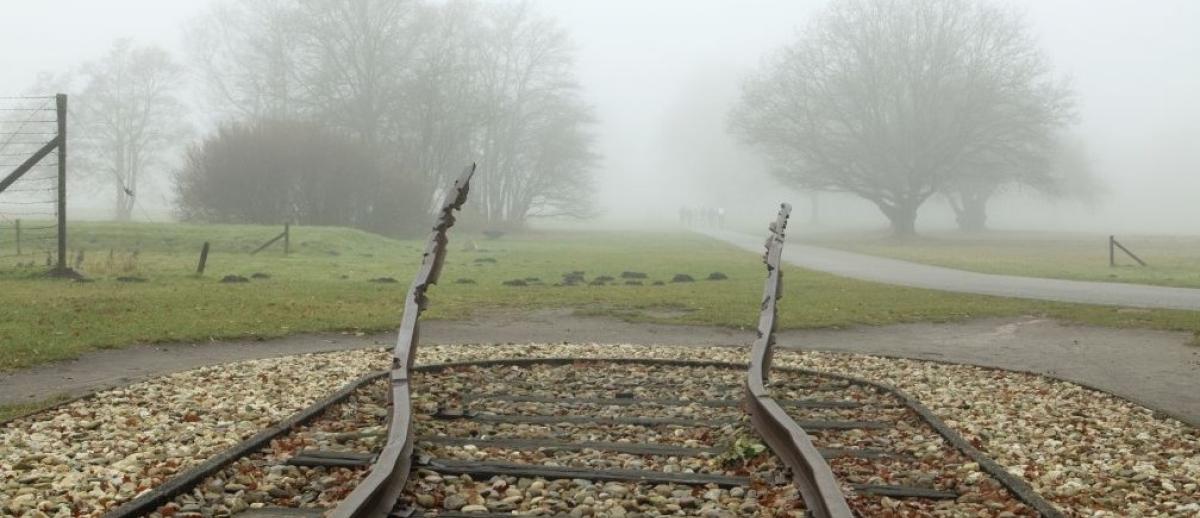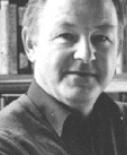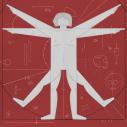The “Brightest” Amongst the Nations
archive


Monument at Westerbork transit camp in the Netherlands, from which Jews were transported to Nazi camps in Germany. (Photo: Patricia Hofmeester/ Shutterstock)
The “Brightest” Amongst the Nations
The war story of Elias Vlessing, a Jewish inhabitant of Holland where at least 75% of the Jewish population was killed during World War II, recently attracted global attention. In 1944, Vlessing was “helped” by a few Dutch lawyers who forty years later were recognized by Israel as “heroes” and “Righteous amongst the Nations.” Many have been honored in this way thanks to global cooperation between the Dutch war-research institute NIOD and a similar Israeli organization, Yad Vashem. Now, the background of this cooperation has been scrutinized in a new study by Petra van den Boomgaard.1
As the first director of Yad Vashem, the Dutchman Jo Milkman initiated a global and lucrative change of Israeli foreign policy. Given this state’s meager juridical legitimacy after the 1947 UNO decision and the rising tide of criticism it was facing for its dubious military actions—including criticism from people like Hannah Arendt and Albert Einstein—some Israelis felt that “Holocaust” legitimation needed to be more explicit. Righteous people, defined as saviors or helpers of Jews in the Shoah, could “give a powerful signal to the German population” to weaken their troubled minds and purses.2 A good idea to help real victims of the Shoah, but not to support Zionists in a remote country fighting a bloody civil war against the indigenous population since 1918 and external wars since 1948.
Back to Elias Vlessing. His story is used in the new study as a model to classify 5,446 similar cases concerning petitioners who tried to escape deportation by challenging the Nazi legal definition of a Jew. With four Jewish grandparents, a 100% Jew was always deported but those with a 50% or 25% status and mixed marriages had “advantages.” The petitioners created large dossiers to prove the lower status, sometimes supported by lawyers, anthropologists, and many other helpers; they had to submit them to the Nazi administration of the jurist Hans Georg Calmeyer who ultimately had the power to decide over matters of life and death.
Vlessing, assisted by his lawyer Lya van den Dries, petitioned Calmeyer in September 1942 to reconsider a previous plea.3 In January 1944 he was “visited by a certain mister Jacob Van Proosdij” who presented himself as “the right-hand man of Calmeyer.” Vlessing was told that his request was “in bad shape.” However, just a few days later he learned that he and his family would be allowed to go to Amsterdam.
Yet once settled there, Elias received a bill from Van Proosdij “for work to be done in the future,” even though he had never requested such assistance. Nevertheless he paid the bill and only few months later Van Proosdij contacted Vlessing again with a new message to the effect that “…your request [to Calmeyer] had now arrived in a very bad phase,” adding that he “could do something about it if payed again.” Elias Vlessing paid again.
Vlessing’s nightmare was not over even after his survival. In nearly the last month of the war Van Proosdij, supported by his colleague Kotting, initiated legal proceedings against Vlessing and demanded a new payment of 675 guilders. Kotting’s argument was curious: the signature below Calmeyer’s decision was falsified by Van Proosdij “and therefore he [Van Proosdij] was responsible for the ‘final granting’ of Elias Vlessing’s request.” In May1946 the court ruled that it “was incompetent” to arrive at a judgment in this fairly typical wartime case.
However, this serious fraud is silenced in the summary of the study, where only Van Proosdij’s Righteous status is talked about (513-518). On another question the author does the same. Yad Vashem heroes must have acted “at the risk of their life,” but the study proves that “the lawyers ran limited risks” (487). Again in the summary the author accepts the lawyers’ post-war stories that the “risks that were run by the lawyers were the most substantial” (619). That the author was aware of the looting behavior of Van Proosdij and Kotting did not seem to matter.4
Elias Vlessing’s story is used… as a model to classify 5,446 similar cases concerning petitioners who tried to escape deportation by challenging the Nazi legal definition of a Jew.
In tiny Holland, to get a doctoral degree on the subject of the war you need a NIOD stamp. In Van den Boomgaard’s case, NIOD’s Johannes Houwink ten Cate had to do this job, but he clearly missed the Vlessing story of how money-grabbing lawyers cheated Jewish victims. Why should he read it? After all, in the summary he was reminded that these were already chosen as Righteous! In his turn, Houwink ten Cate silenced criminal data about one of Van den Boomgaard’s sources, De Froe, who now was called a “resistance hero” (38) and also one of the Righteous (618).
By comparison, Houwink’s former colleague Gerard Aalders, globally well-known for his work on Nazi art theft and banking manipulations, recently published a devastating analysis of the NIOD, which included criticism of Houwink ten Cate.5
In Van den Boomgaard’s dissertation three main concepts are used without relevant explication: “Jew,” “the granting percentage,” and “chance of survival.” Here I offer only a few remarks about them.
The central concept is “Jew,” because all debates about victims, perpetrators, and their assistants revolve around this concept. After all, right or wrong in this matter could mean your death sentence! But the crucial question is: which definition of “Jew” is used by whom, when, and where? There are critical differences when the term is used by “Jews” themselves, by ex-Jews, or by German designers of the pre-war racial laws (jurists like Calmeyer), by the Dutch government before and during the war, and so on. If one makes no distinction between jurists like Calmeyer and the hard-core racists of the SS, it is not understandable why the former could validate a change of race which was impossible for the latter (for whom every Jew has the wrong race), or why Calmeyer was no supporter of racial anthropologists such as De Froe, and why he therefore cannot be called a “hero” or Righteous: he is nothing but an obedient law-abiding jurist applying the existing German (racial) laws!
The next two concepts are both centered only on the helper as personal savior of some victim, which is a precondition to become recognized as Righteous and a consequence of the global political aim of the designating organization, Yad Vashem.
Yad Vashem heroes must have acted 'at the risk of their life,' but the study proves that 'the lawyers ran limited risks.'
First, in the Calmeyer administration the decision to release or to murder petitioners was made on the basis of a dossier full of more or less valuable papers and never through the act of one jurist or anthropologist alone. So, the granting percentage (the percentage of accepted petitions per lawyer; 491) is a fake concept covering a travesty of reality. It is the same reason why the survival percentage (the percent of survived petitioners per helper; 557-564) is fully misleading. Next, the criteria of the decision are given by the racial laws and never by the personal influence of somebody, not even of Calmeyer himself.
As told, Righteous persons acted “at the risk of their life,” but only one of the many hundreds of helpers risked their life for more than a split second (a lawyer named Goldstein was killed, not because he was a helper but because he was a Jew). Next, anthropologists like De Froe or Ariëns Kappers are called “resistance heroes” (37) because sometimes the data they submitted were faked by them. These seemingly subversive behaviors might seem heroic if not for the fact that they are actually part of a broader tradition, or national sport, that continues in the Netherlands until today: tax-evasion! More seriously, in many new archival findings De Froe and Ariëns Kappers have been unmasked as staunch collaborators of the Germans, if not also as war-criminals.6
It is clear, therefore, that these highly dubious “heroes”—Van Proosdij, Kotting, De Froe, Ariëns Kappers, and Calmeyer and their NIOD-Yad Vashem inventors—were neither Righteous nor the Brightest amongst the Nations. Moreover, they demonstrate the shaky sources and reasoning of the Holocaust reconciliation policies of Dutch and Israeli officials.
1. Petra van den Boomgaard, Voor de nazi’s geen Jood. Hoe ruim 2500 Joden door ontduiking van rassenvoorschriften aan de deportaties zijn ontkomen (Hilversum: Verbum, 2019; 671 pp.) “For the Nazis no Jew. How more than 2500 Jews survived deportations by evasion of the race-prescriptions.”
2. Idem, 55.
3. For the following story see Idem, 19-37.
4. She first tells (still vaguely) that according to her own research Van Proosdij "is related […] to 75 cases" (513) and later she reproduces Van Proosdij’s post-war arithmetic and qualifications: in 1946 he had personally saved 100 peoples, in 1960 and later this were already 200 persons (514 note 302); in 2004 "told Van Proosdij still with bravado over his and Kotting’s heroic deeds." (517)
5. Gerard Aalders, Het Instituut. Het NIOD als speelbal van Den Haag en Koningshuis. “The Institute. The NIOD as plaything between The Hague and the Monarchy” (Driebergen: Just Publishers, 2019), 41-43 for more on Houwink ten Cate, who “you never could trust and [who] is known at the Institute as 'Little Brutus,' because you never knew when you’d get a dagger in your back.”
6. Hans Derks, Victims and Perpetrators. Dutch Shoah, 1933/45 and beyond (Paderborn: Schöningh/Brill Germany, 2019), chapters 9-11.



